A Comprehensive Review: Internet of Things for Smart Cities Tech
VerifiedAdded on 2023/06/11
|8
|2174
|351
Report
AI Summary
This report provides a critical review of the paper "Internet of Things for Smart Cities" by Andrea Zanella and Lorenzo Vangelista, focusing on the integration of IoT in urban areas to support the smart city vision. The paper highlights the complexities of building a general architecture for IoT due to the variety of devices, link layer technologies, and services involved. It discusses the use of IoT systems in urban environments, aiming to enhance public services, reduce operational costs, and increase transparency for citizens. The review also covers the challenges in adopting IoT platforms, including the lack of clear business models and technical difficulties. It further explores the potential benefits of urban IoT in areas like transportation, parking, and lighting, as well as its role in promoting citizen participation in public administration. The report concludes by analyzing available solutions for implementing urban IoTs, referencing the Padova Smart City project as a proof-of-concept implementation. Desklib provides access to this and other solved assignments for students.
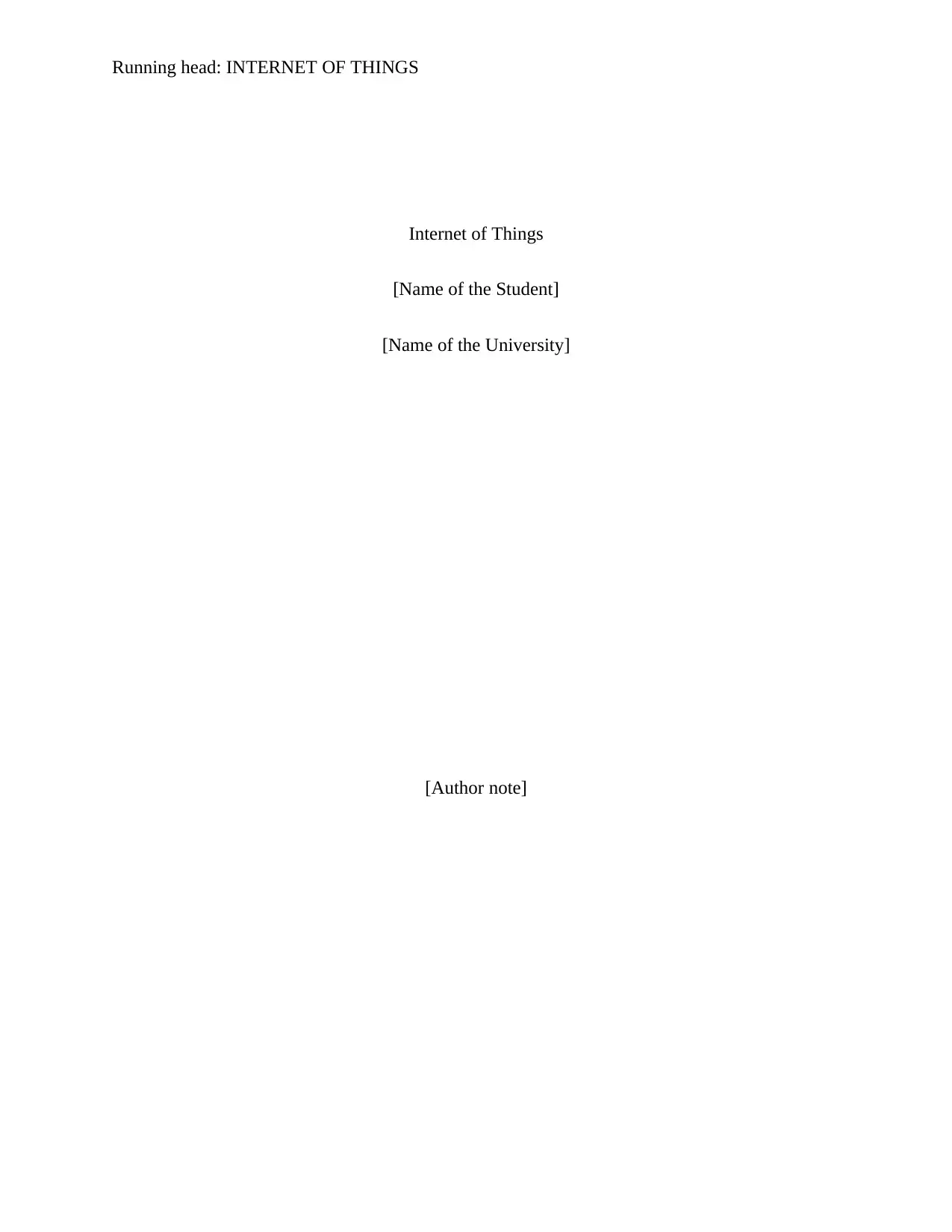
Running head: INTERNET OF THINGS
Internet of Things
[Name of the Student]
[Name of the University]
[Author note]
Internet of Things
[Name of the Student]
[Name of the University]
[Author note]
Paraphrase This Document
Need a fresh take? Get an instant paraphrase of this document with our AI Paraphraser
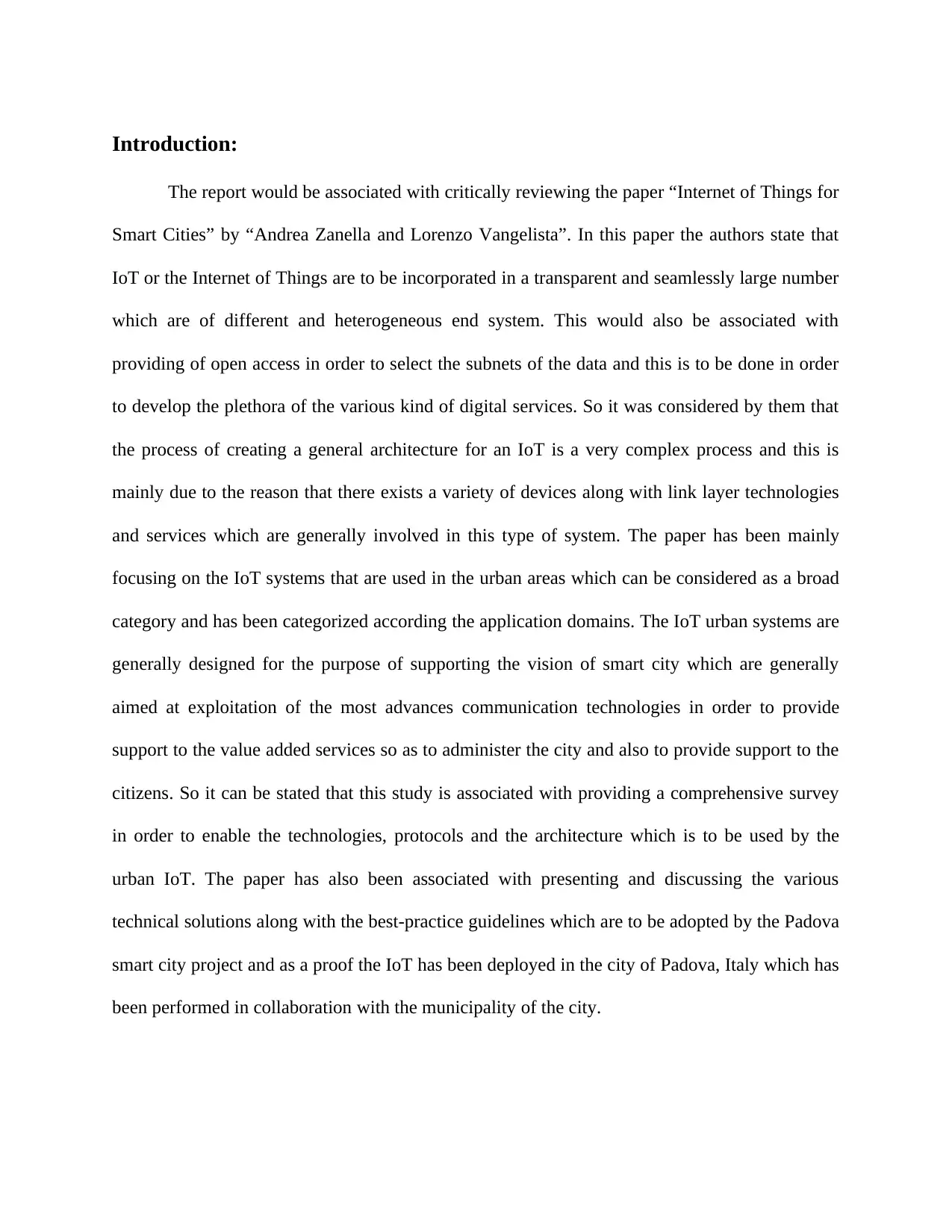
Introduction:
The report would be associated with critically reviewing the paper “Internet of Things for
Smart Cities” by “Andrea Zanella and Lorenzo Vangelista”. In this paper the authors state that
IoT or the Internet of Things are to be incorporated in a transparent and seamlessly large number
which are of different and heterogeneous end system. This would also be associated with
providing of open access in order to select the subnets of the data and this is to be done in order
to develop the plethora of the various kind of digital services. So it was considered by them that
the process of creating a general architecture for an IoT is a very complex process and this is
mainly due to the reason that there exists a variety of devices along with link layer technologies
and services which are generally involved in this type of system. The paper has been mainly
focusing on the IoT systems that are used in the urban areas which can be considered as a broad
category and has been categorized according the application domains. The IoT urban systems are
generally designed for the purpose of supporting the vision of smart city which are generally
aimed at exploitation of the most advances communication technologies in order to provide
support to the value added services so as to administer the city and also to provide support to the
citizens. So it can be stated that this study is associated with providing a comprehensive survey
in order to enable the technologies, protocols and the architecture which is to be used by the
urban IoT. The paper has also been associated with presenting and discussing the various
technical solutions along with the best-practice guidelines which are to be adopted by the Padova
smart city project and as a proof the IoT has been deployed in the city of Padova, Italy which has
been performed in collaboration with the municipality of the city.
The report would be associated with critically reviewing the paper “Internet of Things for
Smart Cities” by “Andrea Zanella and Lorenzo Vangelista”. In this paper the authors state that
IoT or the Internet of Things are to be incorporated in a transparent and seamlessly large number
which are of different and heterogeneous end system. This would also be associated with
providing of open access in order to select the subnets of the data and this is to be done in order
to develop the plethora of the various kind of digital services. So it was considered by them that
the process of creating a general architecture for an IoT is a very complex process and this is
mainly due to the reason that there exists a variety of devices along with link layer technologies
and services which are generally involved in this type of system. The paper has been mainly
focusing on the IoT systems that are used in the urban areas which can be considered as a broad
category and has been categorized according the application domains. The IoT urban systems are
generally designed for the purpose of supporting the vision of smart city which are generally
aimed at exploitation of the most advances communication technologies in order to provide
support to the value added services so as to administer the city and also to provide support to the
citizens. So it can be stated that this study is associated with providing a comprehensive survey
in order to enable the technologies, protocols and the architecture which is to be used by the
urban IoT. The paper has also been associated with presenting and discussing the various
technical solutions along with the best-practice guidelines which are to be adopted by the Padova
smart city project and as a proof the IoT has been deployed in the city of Padova, Italy which has
been performed in collaboration with the municipality of the city.
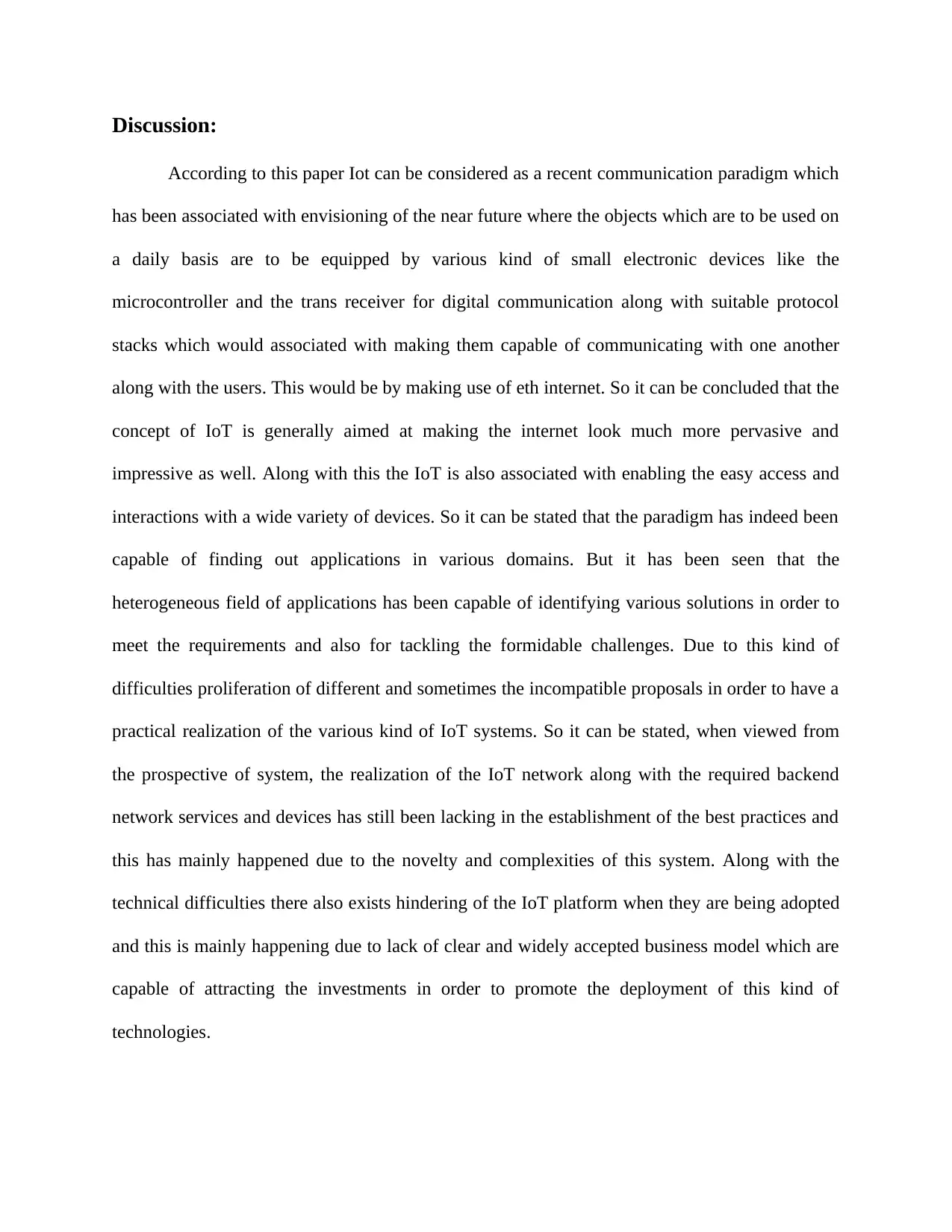
Discussion:
According to this paper Iot can be considered as a recent communication paradigm which
has been associated with envisioning of the near future where the objects which are to be used on
a daily basis are to be equipped by various kind of small electronic devices like the
microcontroller and the trans receiver for digital communication along with suitable protocol
stacks which would associated with making them capable of communicating with one another
along with the users. This would be by making use of eth internet. So it can be concluded that the
concept of IoT is generally aimed at making the internet look much more pervasive and
impressive as well. Along with this the IoT is also associated with enabling the easy access and
interactions with a wide variety of devices. So it can be stated that the paradigm has indeed been
capable of finding out applications in various domains. But it has been seen that the
heterogeneous field of applications has been capable of identifying various solutions in order to
meet the requirements and also for tackling the formidable challenges. Due to this kind of
difficulties proliferation of different and sometimes the incompatible proposals in order to have a
practical realization of the various kind of IoT systems. So it can be stated, when viewed from
the prospective of system, the realization of the IoT network along with the required backend
network services and devices has still been lacking in the establishment of the best practices and
this has mainly happened due to the novelty and complexities of this system. Along with the
technical difficulties there also exists hindering of the IoT platform when they are being adopted
and this is mainly happening due to lack of clear and widely accepted business model which are
capable of attracting the investments in order to promote the deployment of this kind of
technologies.
According to this paper Iot can be considered as a recent communication paradigm which
has been associated with envisioning of the near future where the objects which are to be used on
a daily basis are to be equipped by various kind of small electronic devices like the
microcontroller and the trans receiver for digital communication along with suitable protocol
stacks which would associated with making them capable of communicating with one another
along with the users. This would be by making use of eth internet. So it can be concluded that the
concept of IoT is generally aimed at making the internet look much more pervasive and
impressive as well. Along with this the IoT is also associated with enabling the easy access and
interactions with a wide variety of devices. So it can be stated that the paradigm has indeed been
capable of finding out applications in various domains. But it has been seen that the
heterogeneous field of applications has been capable of identifying various solutions in order to
meet the requirements and also for tackling the formidable challenges. Due to this kind of
difficulties proliferation of different and sometimes the incompatible proposals in order to have a
practical realization of the various kind of IoT systems. So it can be stated, when viewed from
the prospective of system, the realization of the IoT network along with the required backend
network services and devices has still been lacking in the establishment of the best practices and
this has mainly happened due to the novelty and complexities of this system. Along with the
technical difficulties there also exists hindering of the IoT platform when they are being adopted
and this is mainly happening due to lack of clear and widely accepted business model which are
capable of attracting the investments in order to promote the deployment of this kind of
technologies.
⊘ This is a preview!⊘
Do you want full access?
Subscribe today to unlock all pages.

Trusted by 1+ million students worldwide
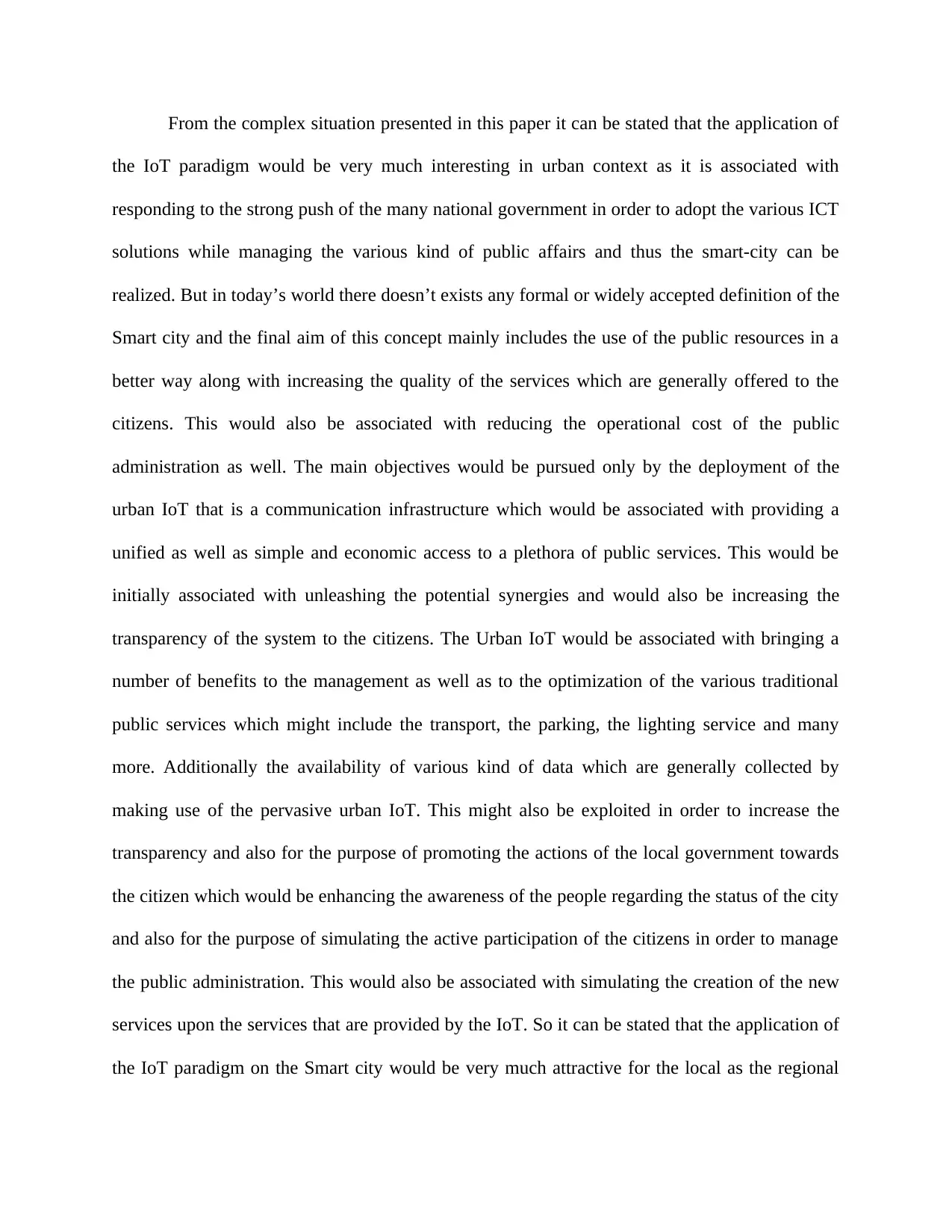
From the complex situation presented in this paper it can be stated that the application of
the IoT paradigm would be very much interesting in urban context as it is associated with
responding to the strong push of the many national government in order to adopt the various ICT
solutions while managing the various kind of public affairs and thus the smart-city can be
realized. But in today’s world there doesn’t exists any formal or widely accepted definition of the
Smart city and the final aim of this concept mainly includes the use of the public resources in a
better way along with increasing the quality of the services which are generally offered to the
citizens. This would also be associated with reducing the operational cost of the public
administration as well. The main objectives would be pursued only by the deployment of the
urban IoT that is a communication infrastructure which would be associated with providing a
unified as well as simple and economic access to a plethora of public services. This would be
initially associated with unleashing the potential synergies and would also be increasing the
transparency of the system to the citizens. The Urban IoT would be associated with bringing a
number of benefits to the management as well as to the optimization of the various traditional
public services which might include the transport, the parking, the lighting service and many
more. Additionally the availability of various kind of data which are generally collected by
making use of the pervasive urban IoT. This might also be exploited in order to increase the
transparency and also for the purpose of promoting the actions of the local government towards
the citizen which would be enhancing the awareness of the people regarding the status of the city
and also for the purpose of simulating the active participation of the citizens in order to manage
the public administration. This would also be associated with simulating the creation of the new
services upon the services that are provided by the IoT. So it can be stated that the application of
the IoT paradigm on the Smart city would be very much attractive for the local as the regional
the IoT paradigm would be very much interesting in urban context as it is associated with
responding to the strong push of the many national government in order to adopt the various ICT
solutions while managing the various kind of public affairs and thus the smart-city can be
realized. But in today’s world there doesn’t exists any formal or widely accepted definition of the
Smart city and the final aim of this concept mainly includes the use of the public resources in a
better way along with increasing the quality of the services which are generally offered to the
citizens. This would also be associated with reducing the operational cost of the public
administration as well. The main objectives would be pursued only by the deployment of the
urban IoT that is a communication infrastructure which would be associated with providing a
unified as well as simple and economic access to a plethora of public services. This would be
initially associated with unleashing the potential synergies and would also be increasing the
transparency of the system to the citizens. The Urban IoT would be associated with bringing a
number of benefits to the management as well as to the optimization of the various traditional
public services which might include the transport, the parking, the lighting service and many
more. Additionally the availability of various kind of data which are generally collected by
making use of the pervasive urban IoT. This might also be exploited in order to increase the
transparency and also for the purpose of promoting the actions of the local government towards
the citizen which would be enhancing the awareness of the people regarding the status of the city
and also for the purpose of simulating the active participation of the citizens in order to manage
the public administration. This would also be associated with simulating the creation of the new
services upon the services that are provided by the IoT. So it can be stated that the application of
the IoT paradigm on the Smart city would be very much attractive for the local as the regional
Paraphrase This Document
Need a fresh take? Get an instant paraphrase of this document with our AI Paraphraser

administration which would be becoming the early adopters of this new technology which would
be acting as one of the catalyzer in order to adopt the IoT paradigm.
The paper has also been associated with discussing the general reference framework
which is for the new design that the urban IoT would be having. The paper has also been
associated with discussing about the characteristics of an urban IoT along with the services
which would be associated with driving the adaptation of the urban IoT by the local
governments. After this an overview of the web-based approach for the purpose of designing the
IoT services along with discussing their suitability for the smart city environment has also been
provided along with the protocols and the technologies which are related to it. After this a
discussion has also been made regarding the sustainability of the Smart city environment. Lastly
they have substantiate the discussion and this has been done by reporting their experience in the
“Padove Smart city” project. This reporting can be considered as a proof-of-concept regarding
the deployment of an IoT island in the city of Padova, Italy and they are interconnected with the
data network of the city municipality. Due to this reason they have been associated with
providing a description regarding the technical solutions which are adopted in order to describe
the technical solutions which are adopted in order to realize the IoT Island and also for the
purpose of reporting some of the measurements which have been collected by the system in first
operational days.
The paper has also been associated with providing an overview of the services which are
commonly associated with the Smart city vision which would initially be enabled by the
deployment of the urban IoT. The paper has also been associated with providing an overview of
the system architecture for the urban IoT.
be acting as one of the catalyzer in order to adopt the IoT paradigm.
The paper has also been associated with discussing the general reference framework
which is for the new design that the urban IoT would be having. The paper has also been
associated with discussing about the characteristics of an urban IoT along with the services
which would be associated with driving the adaptation of the urban IoT by the local
governments. After this an overview of the web-based approach for the purpose of designing the
IoT services along with discussing their suitability for the smart city environment has also been
provided along with the protocols and the technologies which are related to it. After this a
discussion has also been made regarding the sustainability of the Smart city environment. Lastly
they have substantiate the discussion and this has been done by reporting their experience in the
“Padove Smart city” project. This reporting can be considered as a proof-of-concept regarding
the deployment of an IoT island in the city of Padova, Italy and they are interconnected with the
data network of the city municipality. Due to this reason they have been associated with
providing a description regarding the technical solutions which are adopted in order to describe
the technical solutions which are adopted in order to realize the IoT Island and also for the
purpose of reporting some of the measurements which have been collected by the system in first
operational days.
The paper has also been associated with providing an overview of the services which are
commonly associated with the Smart city vision which would initially be enabled by the
deployment of the urban IoT. The paper has also been associated with providing an overview of
the system architecture for the urban IoT.

Conclusion:
The solutions have been analyzed which are generally available in order to implement the
urban IoTs. The technologies which has been discussed in this paper are closely standardized and
besides this the players of the industry have already been associated with taking an active part in
the production of the devices which ae associated with taking advantage of this technologies in
order to enable the interest of the application. Besides this the range of design options for the IoT
system is very wide. This set of open and standardized protocols is significantly smaller in size.
So it can be stated that the enabling technologies are furthermore have been associated with
reaching a level of maturity which is associated with allowing the practical realization of the IoT
solutions and services which generally starts from the field trials which would be hopefully
associated with having a clear view of the uncertainly that is still associated with preventing a
massive adaptation of the IoT paradigm. A concrete proof-of-concept implementation which has
been deployed in collaboration with the city of Padova, Italy can be considered as a relevant
example of the application of the IoT paradigm for the smart cities.
The solutions have been analyzed which are generally available in order to implement the
urban IoTs. The technologies which has been discussed in this paper are closely standardized and
besides this the players of the industry have already been associated with taking an active part in
the production of the devices which ae associated with taking advantage of this technologies in
order to enable the interest of the application. Besides this the range of design options for the IoT
system is very wide. This set of open and standardized protocols is significantly smaller in size.
So it can be stated that the enabling technologies are furthermore have been associated with
reaching a level of maturity which is associated with allowing the practical realization of the IoT
solutions and services which generally starts from the field trials which would be hopefully
associated with having a clear view of the uncertainly that is still associated with preventing a
massive adaptation of the IoT paradigm. A concrete proof-of-concept implementation which has
been deployed in collaboration with the city of Padova, Italy can be considered as a relevant
example of the application of the IoT paradigm for the smart cities.
⊘ This is a preview!⊘
Do you want full access?
Subscribe today to unlock all pages.

Trusted by 1+ million students worldwide
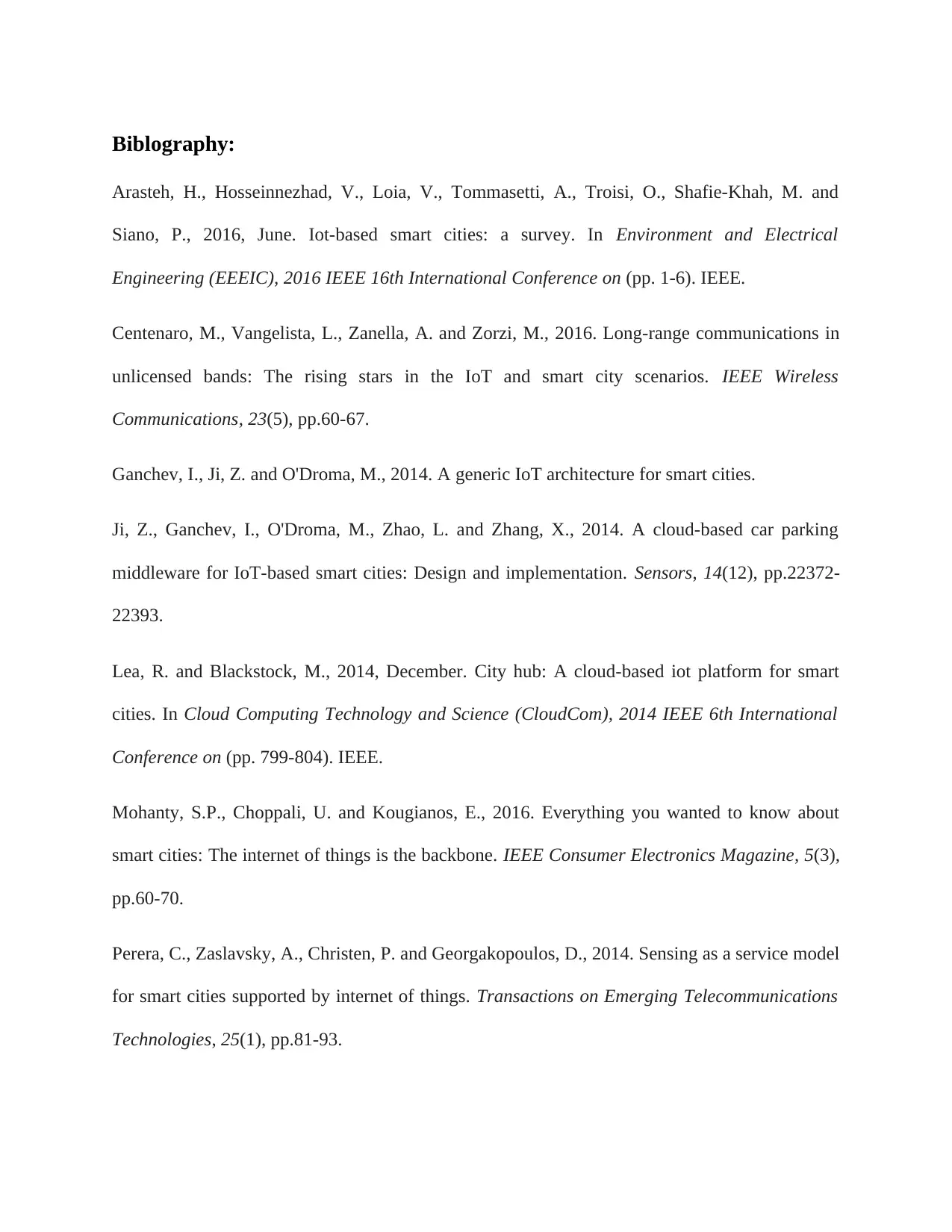
Biblography:
Arasteh, H., Hosseinnezhad, V., Loia, V., Tommasetti, A., Troisi, O., Shafie-Khah, M. and
Siano, P., 2016, June. Iot-based smart cities: a survey. In Environment and Electrical
Engineering (EEEIC), 2016 IEEE 16th International Conference on (pp. 1-6). IEEE.
Centenaro, M., Vangelista, L., Zanella, A. and Zorzi, M., 2016. Long-range communications in
unlicensed bands: The rising stars in the IoT and smart city scenarios. IEEE Wireless
Communications, 23(5), pp.60-67.
Ganchev, I., Ji, Z. and O'Droma, M., 2014. A generic IoT architecture for smart cities.
Ji, Z., Ganchev, I., O'Droma, M., Zhao, L. and Zhang, X., 2014. A cloud-based car parking
middleware for IoT-based smart cities: Design and implementation. Sensors, 14(12), pp.22372-
22393.
Lea, R. and Blackstock, M., 2014, December. City hub: A cloud-based iot platform for smart
cities. In Cloud Computing Technology and Science (CloudCom), 2014 IEEE 6th International
Conference on (pp. 799-804). IEEE.
Mohanty, S.P., Choppali, U. and Kougianos, E., 2016. Everything you wanted to know about
smart cities: The internet of things is the backbone. IEEE Consumer Electronics Magazine, 5(3),
pp.60-70.
Perera, C., Zaslavsky, A., Christen, P. and Georgakopoulos, D., 2014. Sensing as a service model
for smart cities supported by internet of things. Transactions on Emerging Telecommunications
Technologies, 25(1), pp.81-93.
Arasteh, H., Hosseinnezhad, V., Loia, V., Tommasetti, A., Troisi, O., Shafie-Khah, M. and
Siano, P., 2016, June. Iot-based smart cities: a survey. In Environment and Electrical
Engineering (EEEIC), 2016 IEEE 16th International Conference on (pp. 1-6). IEEE.
Centenaro, M., Vangelista, L., Zanella, A. and Zorzi, M., 2016. Long-range communications in
unlicensed bands: The rising stars in the IoT and smart city scenarios. IEEE Wireless
Communications, 23(5), pp.60-67.
Ganchev, I., Ji, Z. and O'Droma, M., 2014. A generic IoT architecture for smart cities.
Ji, Z., Ganchev, I., O'Droma, M., Zhao, L. and Zhang, X., 2014. A cloud-based car parking
middleware for IoT-based smart cities: Design and implementation. Sensors, 14(12), pp.22372-
22393.
Lea, R. and Blackstock, M., 2014, December. City hub: A cloud-based iot platform for smart
cities. In Cloud Computing Technology and Science (CloudCom), 2014 IEEE 6th International
Conference on (pp. 799-804). IEEE.
Mohanty, S.P., Choppali, U. and Kougianos, E., 2016. Everything you wanted to know about
smart cities: The internet of things is the backbone. IEEE Consumer Electronics Magazine, 5(3),
pp.60-70.
Perera, C., Zaslavsky, A., Christen, P. and Georgakopoulos, D., 2014. Sensing as a service model
for smart cities supported by internet of things. Transactions on Emerging Telecommunications
Technologies, 25(1), pp.81-93.
Paraphrase This Document
Need a fresh take? Get an instant paraphrase of this document with our AI Paraphraser
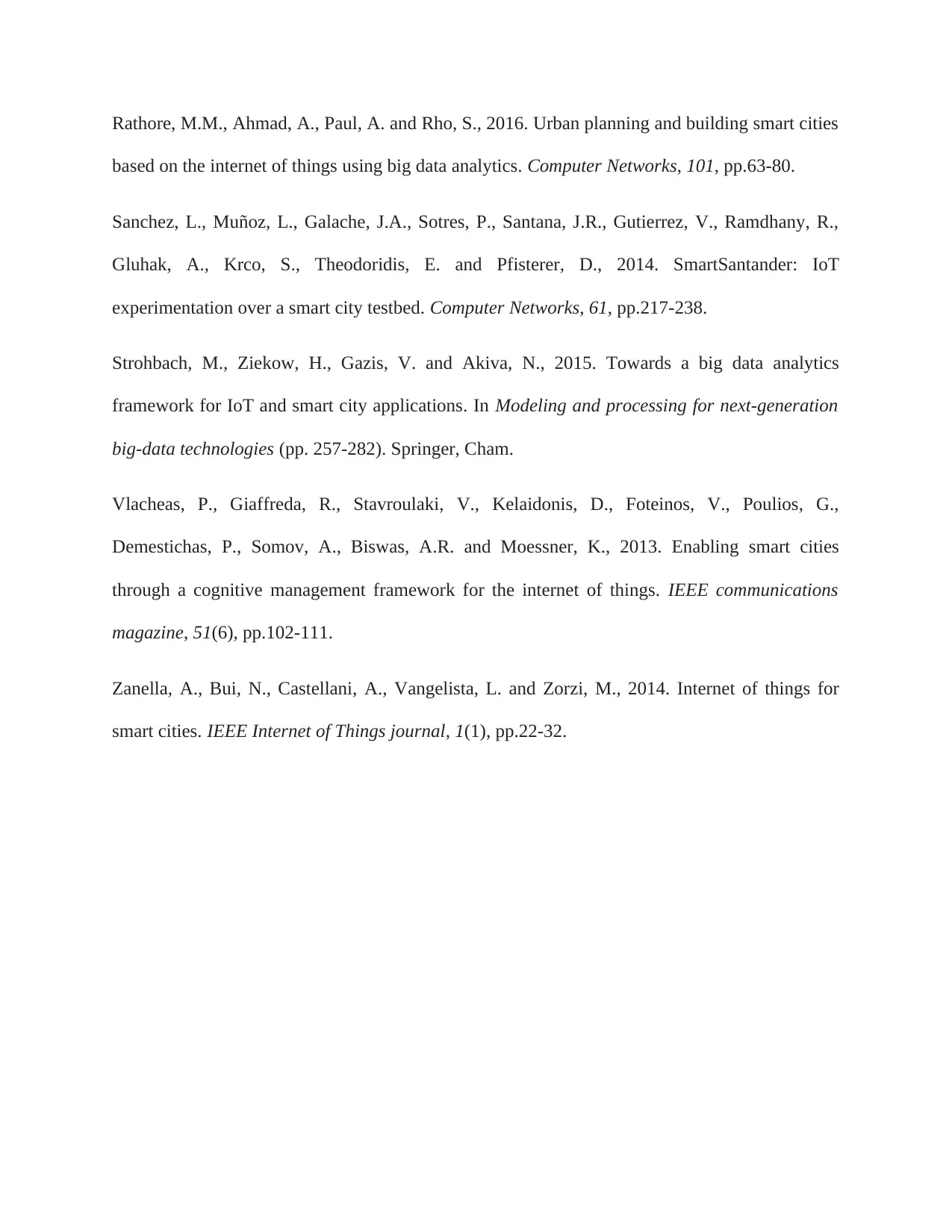
Rathore, M.M., Ahmad, A., Paul, A. and Rho, S., 2016. Urban planning and building smart cities
based on the internet of things using big data analytics. Computer Networks, 101, pp.63-80.
Sanchez, L., Muñoz, L., Galache, J.A., Sotres, P., Santana, J.R., Gutierrez, V., Ramdhany, R.,
Gluhak, A., Krco, S., Theodoridis, E. and Pfisterer, D., 2014. SmartSantander: IoT
experimentation over a smart city testbed. Computer Networks, 61, pp.217-238.
Strohbach, M., Ziekow, H., Gazis, V. and Akiva, N., 2015. Towards a big data analytics
framework for IoT and smart city applications. In Modeling and processing for next-generation
big-data technologies (pp. 257-282). Springer, Cham.
Vlacheas, P., Giaffreda, R., Stavroulaki, V., Kelaidonis, D., Foteinos, V., Poulios, G.,
Demestichas, P., Somov, A., Biswas, A.R. and Moessner, K., 2013. Enabling smart cities
through a cognitive management framework for the internet of things. IEEE communications
magazine, 51(6), pp.102-111.
Zanella, A., Bui, N., Castellani, A., Vangelista, L. and Zorzi, M., 2014. Internet of things for
smart cities. IEEE Internet of Things journal, 1(1), pp.22-32.
based on the internet of things using big data analytics. Computer Networks, 101, pp.63-80.
Sanchez, L., Muñoz, L., Galache, J.A., Sotres, P., Santana, J.R., Gutierrez, V., Ramdhany, R.,
Gluhak, A., Krco, S., Theodoridis, E. and Pfisterer, D., 2014. SmartSantander: IoT
experimentation over a smart city testbed. Computer Networks, 61, pp.217-238.
Strohbach, M., Ziekow, H., Gazis, V. and Akiva, N., 2015. Towards a big data analytics
framework for IoT and smart city applications. In Modeling and processing for next-generation
big-data technologies (pp. 257-282). Springer, Cham.
Vlacheas, P., Giaffreda, R., Stavroulaki, V., Kelaidonis, D., Foteinos, V., Poulios, G.,
Demestichas, P., Somov, A., Biswas, A.R. and Moessner, K., 2013. Enabling smart cities
through a cognitive management framework for the internet of things. IEEE communications
magazine, 51(6), pp.102-111.
Zanella, A., Bui, N., Castellani, A., Vangelista, L. and Zorzi, M., 2014. Internet of things for
smart cities. IEEE Internet of Things journal, 1(1), pp.22-32.
1 out of 8
Related Documents
Your All-in-One AI-Powered Toolkit for Academic Success.
+13062052269
info@desklib.com
Available 24*7 on WhatsApp / Email
![[object Object]](/_next/static/media/star-bottom.7253800d.svg)
Unlock your academic potential
Copyright © 2020–2025 A2Z Services. All Rights Reserved. Developed and managed by ZUCOL.



